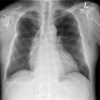A 74-year-old man with mild chronic obstructive pulmonary disease, hepatitis B virus–positive hepatocellular carcinoma, and liver cirrhosis, with suspected hypopharyngeal carcinoma, was scheduled to undergo laser-assisted partial hypopharyngectomy. He had a history of Ivor-Lewis esophagectomy for esophageal cancer performed at 59 years of age. Video-assisted mediastinoscopic lymphadenectomy for lymph node biopsy and neck dissection was planned. No premedication was given, and the fasting period was over 13 hours. The patient entered the operating room with a nasogastric tube inserted. Standard monitoring devices were connected, and general anesthesia induction was planned to be performed by rapid sequence induction.
Denitrogenation with 100% oxygen was performed for 3 minutes, followed by intravenous injection of 2 mg/kg of propofol, 1.5 mg/kg of succinylcholine, and 40 mg of lidocaine. During Mallinckrodt laser-tube intubation using a video laryngoscope (McGrath™, Aircraft Medical, United Kingdom), reflux of yellowish-green gastric fluid into the oral cavity was observed (
Video 1). As the laryngoscopic view Cormack and Lehane grade was 1, endotracheal intubation was not considered to be difficult, and we decided to suction after intubation. However, intubation was not successful at the first attempt. As the endotracheal tube did not pass beyond the vocal cords, further manipulation of the endotracheal tube near the vocal cord was necessary. The refluxed fluid aspirated into the lungs while manipulating the tube. After suctioning the oral cavity, without removing the tube the video laryngoscope was used to confirm the success of the intubation and the tube was ballooned. Immediately after the intubation, fluid of similar color was aspirated on endotracheal suctioning, and 50 to 100 mL of gastric fluid was drained from the nasogastric tube. During induction, the nasogastric tube was naturally drained. Since the vital signs including the peripheral capillary oxygen saturation (SpO
2), as measured by pulse oximetry, were stable, the operation was performed as planned. During laser partial hypopharyngectomy, the fraction of inspired oxygen (FiO
2) was maintained at 0.35 to 0.40 and the SpO
2 at 95% to 96%. Blood gas analysis showed pH of 7.48, PCO
2 of 35 mm Hg, and PO
2 of 55 mmHg at FiO
2 0.4. After 20 minutes, blood gas analysis reperformed at FiO
2 0.5 showed a pH of 7.43, PCO
2 of 39 mmHg, and PO
2 of 81 mmHg. No fluid or particular reflux was observed in the airway using the laryngoscope when the anode tube was replaced an hour later. During the 4 hours of operation, the vital signs were stable, and the SpO
2 remained at 100% at FiO
2 0.5. Blood gas analysis performed just before the end of surgery showed pH of 7.41, PCO
2 of 41 mm Hg, and PO
2 of 119 mm Hg at FiO
2 0.5. After the operation, the patient was extubated and transferred to the post-anesthetic care unit without dyspnea. Postoperative chest radiography showed diffuse haziness in the left upper lobe compared with the preoperative image (
Figure 1,
Figure 2A). The SpO
2 decreased to 88% in room air in the post-anesthetic care unit, and the patient was transferred to the ward with a simple mask delivering O
2 at 6 L/min, following which the SpO
2 was well maintained. The patient received conservative care without antibiotic therapy for the pulmonary aspiration. The patient had mild chronic obstructive pulmonary disease and was diagnosed with cancer-associated segmental pulmonary thromboembolism after surgery. The SpO
2 was maintained with a simple mask delivering O
2 at 3 L/min until the day before discharge. The patient was discharged on postoperative day 12 without complications related to pulmonary aspiration (
Figure 2B).












 PDF
PDF ePub
ePub Citation
Citation Print
Print





 XML Download
XML Download